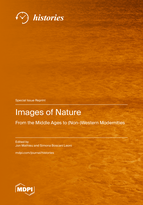Images of Nature—From the Middle Ages to (Non-)Western Modernities
A special issue of Histories (ISSN 2409-9252). This special issue belongs to the section "Environmental History".
Deadline for manuscript submissions: closed (31 March 2023) | Viewed by 19048
Special Issue Editors
Interests: mountain history; family and kinship history; agrarian history
Special Issues, Collections and Topics in MDPI journals
Special Issue Information
Dear Colleagues,
Natura is a polysemic Latin word that has accompanied the historical development of the West for centuries, spreading around much of the globe with colonialism and imperialism. It has been adopted in numerous languages. Our relationship with nature has become a highly charged issue at least since the "ecological turn" around 1970. It is as much about the relationship of humans to the environment as it is about the relationship of humans to each other. In the wake of these problems and debates, research has intensified in a variety of disciplines: history, anthropology, philosophy, literature, ecology, etc., each in its disciplinary expression or in interdisciplinary combinations.
Part of this lively, heterogeneous research deals with the level of perception. What images of nature exist in what historical contexts, under what conditions, and with what consequences? Meant are "images" in the broad sense of the word, as an articulated idea, narrative and drawing, taken as representations or equivalences of underlying phenomena. Do these natures stand in opposition to other ideas? Say the ideas of the supernatural, the unnatural, the human, the divine, the cultural, and so on. Furthermore, in what contexts are the images politically activated: colonialism, nationalism, racism, universalism, indigenism?
The collection of articles on "Images of Nature" plans to address these questions in a long-term perspective, from the European Middle Ages through the early modern period to the postcolonial, global present. In doing so, we focus on three influences:
- Impact of Religion since the Middle Ages: Christianity spread a peculiar view of nature, which was varied in many ways in theological debates; contributions to other faiths that were represented in the West are also possible topics.
- Impact of Science since the early modern period: Research in natural history gave an enormous boost to the imagery of nature since the 16th and 17th centuries, which continued and intensified during the Enlightenment and further on.
- Impact of Environmentalism since decolonization: The increasing critique of Western society, religion, and science, brought a turn to ecology and, at the same time, to indigenous peoples, who often functioned as postcolonial models. These are the current tensions structuring much of our research.
Please submit your contribution to the Special Issue to guest editor Jon Mathieu by December 31, 2022 (jon.mathieu@unilu.ch). You can also submit a proposal, by October 31, in order to discuss the topic with Jon Mathieu and Simona Boscani Leoni before the elaboration of the article. After this preview, the articles follow the ordinary manuscript submission proceeding of Histories. There will be no Article Processing Charges for this Special Issue, but a serious single-blind peer review process.
A guide for authors and other relevant information for submission of manuscripts is available on the Instructions for Authors page. Submitted papers should be well formatted and use good English. Authors may use MDPI's English editing service prior to publication or during author revisions.
Prof. em. Jon Mathieu
Prof. Dr. Simona Boscani Leoni
Guest Editors
Manuscript Submission Information
Manuscripts should be submitted online at www.mdpi.com by registering and logging in to this website. Once you are registered, click here to go to the submission form. Manuscripts can be submitted until the deadline. All submissions that pass pre-check are peer-reviewed. Accepted papers will be published continuously in the journal (as soon as accepted) and will be listed together on the special issue website. Research articles, review articles as well as short communications are invited. For planned papers, a title and short abstract (about 100 words) can be sent to the Editorial Office for announcement on this website.
Submitted manuscripts should not have been published previously, nor be under consideration for publication elsewhere (except conference proceedings papers). All manuscripts are thoroughly refereed through a single-blind peer-review process. A guide for authors and other relevant information for submission of manuscripts is available on the Instructions for Authors page. Histories is an international peer-reviewed open access quarterly journal published by MDPI.
Please visit the Instructions for Authors page before submitting a manuscript. The Article Processing Charge (APC) for publication in this open access journal is 1000 CHF (Swiss Francs). Submitted papers should be well formatted and use good English. Authors may use MDPI's English editing service prior to publication or during author revisions.
Keywords
- long-term history
- views of "nature(s)"
- role of religion
- role of science
- role of environmentalism





